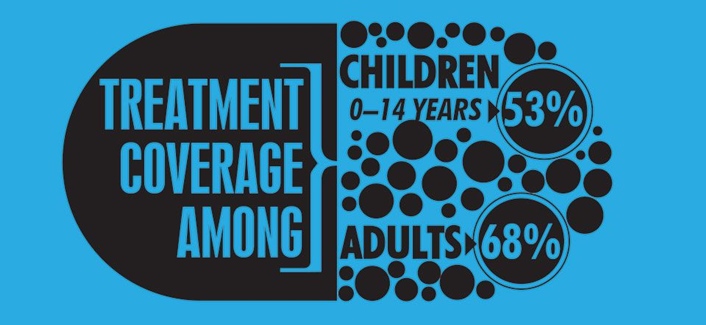Inside This Issue: Preview of Viral Hepatitis Plan; calls for improved HIV treatment access for children; new report on SSPs; RWHAP funding opportunities, and updated perinatal HIV treatment guidelines.
Viral Hepatitis
Coming Soon: National Viral Hepatitis Strategic Plan for 2021-2025
On January 7, the U.S. Department of Health and Human Services (HHS) will release the Viral Hepatitis National Strategic Plan for the United States: A Roadmap to Elimination (2021–2025). The Viral Hepatitis Plan provides a framework for the elimination of viral hepatitis as a public health threat in the U.S. by 2030. It focuses on hepatitis A, B, and C – the three most common hepatitis viruses with the greatest impact on health. According to HHS, “The Plan is necessary as the nation faces unprecedented hepatitis A outbreaks, progress on preventing hepatitis B has stalled, and hepatitis C rates nearly tripled from 2011 to 2018. The Plan provides goal-oriented objectives and strategies that can be implemented by a broad mix of stakeholders at all levels and across many sectors, both public and private, to reverse the rates of viral hepatitis, prevent new infections, improve care and treatment and ultimately eliminate viral hepatitis as a public health threat in the U.S.” HHS will hold a Viral Hepatitis National Strategic Plan Rollout Webinar on January 7 at 2 p.m. Eastern Time. If you are interested in attending, you may register for the webinar on this page. We plan to include a detailed summary of the Plan in the next issue of In Brief.
Global HIV Epidemic
PEPFAR and International Groups Call for Improved Access to HIV Treatment for Infants and Children
The U.S. President’s Emergency Plan for AIDS Relief (PEPFAR), UNAIDS, the United Nations Children’s Fund, and four other international agencies and organizations recently issued a joint statement calling on countries to rapidly scale up access to optimal, child-friendly HIV treatment for infants and children. “Children living with HIV continue to be left behind by the global AIDS response,” according to UNAIDS. In 2019, only 53% (950,000) of the 1.8 million children with HIV aged 14 years or younger were diagnosed and on treatment, compared to 68% of adults. Two-thirds of the remaining 850,000 children were between the ages of 5 and 14 years and did not routinely access the services of traditional health facilities. An estimated 95,000 children died of HIV-related illnesses in 2019, in part due to lack of early diagnosis of HIV among infants and children and immediate linkage to optimal HIV treatment regimens. The U.S. Food and Drug Administration recently gave tentative approval for the first generic formulation of dolutegravir (DTG) 10 mg dispersible tablets – a drug that has been shown to improve health outcomes in children with HIV.
“PEPFAR works tirelessly to ensure clients can access the best available HIV treatment, including advanced, pediatric regimens for children living with HIV,” noted Dr. Deborah Birx, U.S. Global AIDS coordinator and special representative for global health diplomacy. “The accelerated introduction and expansion of pediatric DTG has the potential to save and improve the lives of thousands of children around the world. PEPFAR will continue to collaborate with global and local partners to ensure the young children we serve can promptly access pediatric DTG.”
Syringe Services Programs
New CDC and NASTAD Report Examines Elements of Success for SSPs
Last month, CDC released Syringe Services Programs: A Technical Package of Effective Strategies and Approaches for Planning, Design, and Implementation. This 33-page document, which was developed in partnership with the National Alliance of State and Territorial AIDS Directors (NASTAD), presents evidence on the effectiveness of strategies and approaches that support the successful planning, design, implementation, and sustainability of syringe services programs (SSPs). These community-based prevention programs provide a range of services, including: access to sterile syringes and injection equipment; linkage to substance use disorder treatment; and vaccination, testing, and linkage to care and treatment of HIV, viral hepatitis, and other infections.
The technical package “provides a broad framework for new and existing SSPs to ensure needs-based service delivery, reduce harms related to injection drug use, and link participants to services that support their health and wellness,” according to CDC and NASTAD. “This was developed through a review of scientific literature as well as from the experiences and current practices of a diverse mix of SSP directors, key stakeholders, and experts in harm reduction.”
In particular, the document focuses on the following key SSP strategies and approaches:
- involving people with lived experience and recognizing the expertise of SSP participants in design, policies, and implementation;
- using a needs-based distribution approach, recognizing that access to a sufficient number of sterile syringes is a key component of a comprehensive strategy aimed at limiting the spread of infectious disease among people who inject drugs;
- providing core services (syringe distribution and safe disposal) and expanded services (such as infectious disease screening and treatment);
- collecting data at syringe services programs on trends, needs, and program effectiveness; and
- ensuring program sustainability.
Funding Opportunities
Current Funding Opportunities Available for the RWHAP
The Health Resources and Services Administration HIV/AIDS Bureau currently has six funding opportunities out for applications under the Ryan White HIV/AIDS Program (RWHAP). For your convenience, we are providing brief descriptions of these opportunities, the application deadlines, and links for further information.
HRSA-21-059: RWHAP Part D – Women, Infants, Children, and Youth (WICY) Grants Supplemental Funding. This funding is “to strengthen organizational capacity to respond to the changing health care landscape and increase access to high quality family-centered HIV primary health care services for low income, uninsured, and underserved WICY with HIV.” Applications are due January 12.
HRSA-21-083: Building Capacity to Improve Collecting and Reporting Viral Suppression Data to the Medicaid Adult Core Set. Funding is for one System Coordination Provider “to select, fund, and work with up to 10 RWHAP Part B recipients, and HIV surveillance and Medicaid programs to build capacity to report high-quality HIV viral suppression data to the Centers for Medicare & Medicaid Services as part of the annual state Medicaid Adult Core Set reporting.” Applications are due February 16.
HRSA-21-058: RWHAP Part C Capacity Development Program. “The purpose of this program is to strengthen organizational capacity to respond to the changing health care landscape and increase access to high-quality HIV primary health care services for low-income, uninsured, and underserved people with HIV.” Applications are due February 19.
HRSA-21-068: Special Projects of National Significance (SPNS) Initiative, Using Innovative Intervention Strategies to Improve Health Outcomes Among People with HIV – Evaluation Center. “The purpose of this initiative is to use an implementation science framework to evaluate the pilot testing of innovative intervention strategies in four focus areas at implementation sites subawarded through the companion cooperative agreement . . . and to disseminate the evaluation findings.” Applications are due March 8.
HRSA-21-076: SPNS Initiative, Using Innovative Intervention Strategies to Improve Health Outcomes Among People with HIV – Coordinating Center. “The purpose of this initiative is to use an implementation science framework to identify innovative intervention strategies in four focus areas, pilot test the intervention strategies at subawarded sites and provide technical assistance (TA), and develop replication tools and products.” Applications are due March 8.
HRSA-21-056: Part F Dental Reimbursement. This funding is “to improve access to oral health care services for low-income, uninsured, and underserved people with HIV and to support related education and training for the delivery of dental care to people with HIV.” Applications are due March 12.
Guidelines and Recommendations
HHS Releases Updated Perinatal HIV Treatment Guidelines
An HHS expert panel recently updated the Recommendations for the Use of Antiretroviral Drugs in Pregnant Women with HIV Infection and Interventions to Reduce Perinatal HIV Transmission in the United States. Key updates to the guidelines include:
- the addition of a new section on the use of pre-exposure prophylaxis (PrEP) in women at risk for HIV who are trying to conceive or are pregnant, postpartum, or breastfeeding;
- the addition of a new table summarizing recommendations on the scheduling of HIV-related lab testing for pregnant women with HIV;
- the reorganization of the section on intrapartum care for women with HIV to provide easier access to information about intrapartum antiretroviral therapy/prophylaxis, transmission, mode of delivery, and other care considerations; and
- updated situation-specific recommendations on the use of antiretroviral drugs (ARVs) in pregnant women and nonpregnant women who are trying to conceive, based on data available as of December 2020. In particular, the expert panel modified some of its recommendations regarding the use of dolutegravir, lopinovir/ritonavir, and tenofovir alafenamide for these women.
Educational Resources
TargetHIV Posts Videos from 2020 Ryan White Conference
TargetHIV has uploaded to its YouTube channel over 300 videos of workshop sessions convened at the Virtual 2020 National Ryan White Conference on HIV Care & Treatment (RW2020), which was held on August 11 through 14. The videos have been organized into categories that include the RW2020’s business session as well as its six conference tracks:
- Population-based approaches for improving access, engagement/reengagement, and health outcomes;
- Data utilization;
- Innovative system-level models for HIV service delivery;
- Clinical quality management;
- RWHAP planning and resource allocation: Community engagement and collaborative partnerships; and
- RWHAP fiscal and grant management boot camp.
The TargetHIV YouTube channel also includes a range of topical playlists for the RW2020 videos, such as substance use, oral healthcare, employment, technology, and the Ending the HIV Epidemic initiative. TargetHIV plans to roll out links and search options for accessing sessions via its website later this month.
AVAC Launches New Online Learning Platform
The HIV vaccine and prevention advocacy organization AVAC recently launched Engage, a new online platform for peer-to-peer resource sharing, collaborative learning, and joint strategy development. The Engage platform includes:
- free online courses, both self-guided and facilitated;
- webinars and pop-up conversations on topics related to vaccine and HIV prevention research and development; and
- “network spaces,” where platform users can connect with experts, find and post resources, and contribute to conversations with peers in forums organized around a central theme.
Engage currently has free online courses on strengthening stakeholder engagement; understanding mathematical modeling; collecting, analyzing, and using data; and understanding and applying Good Participatory Practice guidelines for stakeholders.
COVID-19 Research
Recent COVID-19 Reports from MMWR
CDC’s Morbidity and Mortality Weekly Report (MMWR) is continuing to provide extensive coverage of COVID-19-related research. The reports are aggregated on a page devoted to studies about COVID-19 and summarized in a weekly podcast. For your convenience, we have compiled links to recent MMWR papers below:
- Implications of Shortened Quarantine Among Household Contacts of Index Patients with Confirmed SARS-CoV-2 Infection – Tennessee and Wisconsin, April-September 2020
- Performance of an Antigen-Based Test for Asymptomatic and Symptomatic SARS-CoV-2 Testing at Two University Campuses – Wisconsin, September-October 2020
- Impact of COVID-19 Pandemic on Global Poliovirus Surveillance
- The Advisory Committee on Immunization Practices’ Updated Interim Recommendation for Allocation of COVID-19 Vaccine – United States, December 2020
- COVID-19 Stats: COVID-19 Incidence, by Age Group – United States, March 1-November 14, 2020








%202%20-%20small.jpeg)

